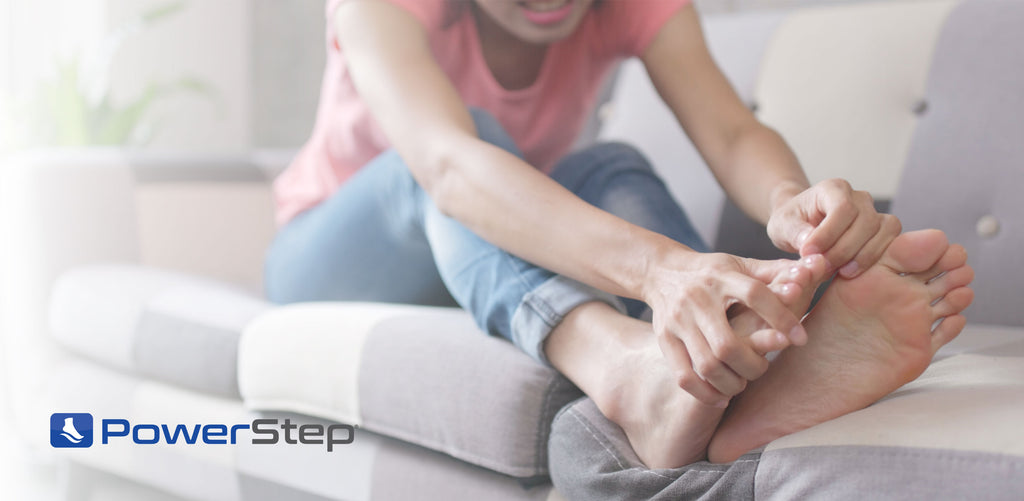Wearing Orthotic Insoles for Sesamoiditis

What is Sesamoiditis?
Sesamoid bones are bones that attach to tendons and muscles. There are two small sesamoid bones in the ball of the foot underneath the big toe joint. Sesamoiditis happens when these bones and the tendons they attach to become inflamed through excess strain.
Treatments often include rest and taking anti-inflammatories. Wearing insoles for sesamoiditis can also relieve pain, improve range of motion, and prevent the condition.
Learn more about the causes, symptoms, and treatment options for sesamoiditis plus how PowerStep® orthotic insoles for ball of foot pain might help.

Symptoms
Sesamoiditis starts out feeling like a dull, aching pain in the big toe area that gradually worsens. You might notice a “popping” sensation when walking or have a hard time bending or straightening the toe. When the pain worsens, walking becomes difficult.
Other sesamoiditis symptoms include:
- Stiffness in the big toe
- Ball of foot pain
- Swelling
- Bruising
- Redness
- Pain when bending the big toe
Serious pain or swelling could also be signs of a stress fracture. Talk to a healthcare provider immediately if you think you have a foot injury.
Causes & Risk Factors
The main cause of sesamoiditis is excess strain on the balls of the feet. This can happen through high impact activities like running, basketball, and dancing, or wearing shoes like high heels that put stress on the forefoot.
Other risk factors for developing sesamoiditis are:
- Wearing high heels or ill-fitting shoes
- Having flat feet
- Having high arches
- Overpronating
- As a rare side effect of gout

Can Orthotic Insoles Help Sesamoiditis?
Orthotic insoles improve symptoms of sesamoiditis by cushioning and redistributing weight away from the big toe joint through the rest of the forefoot for improved movement. By putting less stress on the sesamoid bones, sesamoiditis insoles relieve pressure and pain.
While custom orthotics may be necessary for severe cases of sesamoiditis, some over-the-counter shoe inserts may also provide enough support.
PowerStep Orthotic Insoles for Ball of Foot Pain
As the #1 brand of insoles recommend by podiatrists, PowerStep orthotics can help prevent and relieve ball of foot pain from sesamoiditis by cushioning the balls of the feet and improving alignment of the foot and lower body.
The big toe helps maintain alignment of the foot and lower leg when you walk. The sesamoid bones and tendons that control the big toe originate from a muscle at the heel. It is important your foot has enough support from heel to toe for it to function properly.
More than an over-the-counter shoe insert, PowerStep orthotic insoles offer proper heel and arch support that promotes better alignment of the feet, ankles and lower body for improved biomechanics and range of motion.

Conditions that may lead to sesamoiditis can also be managed using PowerStep orthotics including our orthotics for flat feet, high arch insoles, and insoles for metatarsalgia.
PowerStep PULSE® Plus Met insoles help absorb shock and relieve ball of foot pain after running, while PowerStep Pinnacle® Plus Met insoles offer the best arch and metatarsal support in everyday shoes.
Ways to Treat Sesamoiditis
Sesamoiditis treatment usually involves resting, icing the affected area, and taking anti-inflammatories like NSAIDs. Avoid whatever activity caused your pain whether that means trying low-impact exercises for runners or wearing flats instead of high heels.
Other types of intervention may be necessary depending on severity, including:
- Talking to your doctor: Always seek medical attention or see a podiatrist before treating sesamoiditis at home. They can make a formal diagnosis and rule out potential injuries.
- Resting: Sesamoiditis occurs from repetitive stress, so staying off your feet until symptoms ease can help with healing.
- Reducing activity: Activities that put pressure on the metatarsals, especially running or sports, should be avoided until after treatment.
- Taping: Sesamoiditis taping involves temporarily taping the big toe to the second toe and can help immobilize or restrict the joint as it recovers.
- Exercises: Foot stretches, toe curls, and other sesamoiditis exercises are useful in treating causes of the condition and relieving pain.
- Steroids: For ongoing pain, corticosteroid injections help reduce discomfort and inflammation.
- Physical therapy: After taping or immobilizing the big toe joint with a lower leg brace, physical therapy may be necessary to restore range of motion.
- Surgery: Although it is a last resort, some chronic cases of sesamoiditis require the surgical removal of one of the sesamoid bones.
Prevention
Wearing orthotic insoles with arch support during activities that put weight on the balls of the feet helps absorb impact and support the sesamoid bones, preventing pain in the big toe joint. The most effective ways to prevent sesamoiditis include:
- Wear comfortable shoes that fit and have a wide enough toe box.
- Replace your running shoes when you notice a loss of support or cushion.
- Use PowerStep everyday insoles or running shoe insoles for podiatrist recommended support plus pain relief and prevention.

Prevent & Relieve Pain with PowerStep Orthotic Insoles
Sesamoiditis is a painful foot condition often caused by excess strain on the small sesamoid bones and tendons of the big toe joint. Shoe insoles like PowerStep orthotic insoles are devices that can help relieve mild ball of foot pain, improve range of motion, and may help prevent sesamoiditis from developing.
References:
Roland, J. (2017, August 10) What Is Sesamoiditis and How Is It Treated?. Healthline.
Sesamoiditis: Will Orthotics Help? (n.d.) Rocky Mountain Foot & Ankle Center.
Sesamoiditis: What Is It, Symptoms, Causes & Treatment. (2021, August 8). Cleveland Clinic.







